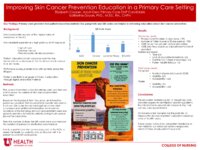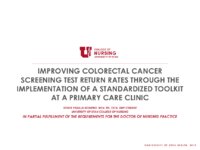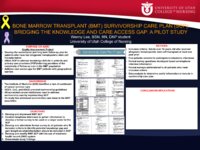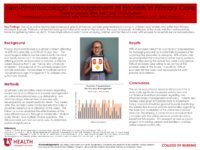The Graduate Nursing Project collection includes Doctor of Nursing Practice (DNP) Scholarly Projects and Master's students' non-thesis projects submitted as part of program requirements.
TO
- Graduate Nursing Project, Doctor of Nursing Practice, DNP18
- Graduate Nursing Project, Doctor of Nursing Practice, DNP, Primary Care / FNP2
- Graduate Nursing Project, Doctor of Nursing Practice, DNP, Primary Care / FNP, Poster2
- Graduate Nursing Project, Doctor of Nursing Practice, DNP, Primary Care FNP2
- Graduate Nursing Project, Doctor of Nursing Practice, DNP, Poster1
- More
| Title | Creator | Date | Description | Relation Is Part Of | ||
|---|---|---|---|---|---|---|
| 1 |
 |
Primary Care: Filling the Gap for Stage I & II Early Stage Breast Cancer Follow-up | Bond-Jorgensen, Stacy | 2015 | With earlier detection, more women are being diagnosed with early stage breast cancer and these women all need follow-up care. Simultaneously, there are concerns about a projected shortage in the work force of oncology specialists to care for these patients. Primary care providers can fill the gap f... | Graduate Nursing Project, Doctor of Nursing Practice, DNP |
| 2 |
 |
Improving Skin Cancer Prevention Education in a Primary Care Setting | Cooper, Elizabeth C.; Doyon, Katherine | 2022 | Background: Utah has consistently led the nation in the rate of melanoma diagnoses. Even though the melanoma mortality rate has slowed due to cancer treatment advances, the incidence rate in Utah has increased. Over the past 17 years, the rate of melanoma diagnoses has increased from 20.5 to 38.9 ca... | Graduate Nursing Project, Doctor of Nursing Practice, DNP, Primary Care, Adult / Gerontology |
| 3 |
 |
Improving Skin Cancer Prevention Education in a Primary Care Setting | Cooper, Elizabeth C.; Doyon, Katherine | 2022 | POSTER | Graduate Nursing Project, Doctor of Nursing Practice, DNP, Primary Care, Adult / Gerontology, Poster |
| 4 |
 |
Improving Colorectal Cancer Screening Through the Implementation of a Standardized Toolkit at a Primary Care Clinic: A Quality Improvement Project | Padilla-Romero, Sonia | 2023 | POSTER | Graduate Nursing Project, Doctor of Nursing Practice, DNP, Primary Care / FNP, Poster |
| 5 |
 |
Improving Colorectal Cancer Screening Through the Implementation of a Standardized Toolkit at a Primary Care Clinic: A Quality Improvement Project | Padillo-Romero, Sonia | 2023 | Background: The COVID-19 pandemic left a national gap in preventative cancer care; more specifically, colorectal cancer (CRC) screening decreased by 82% in from April 2019 to May 2020. This left patients at risk for delayed early detection, disease progression, and mortality. Local Problem: Similarl... | Graduate Nursing Project, Doctor of Nursing Practice, DNP, Primary Care / FNP |
| 6 |
 |
Disparities in Cancer Pain Assessment and Management among Ethnic Minorities | Kogan, Laura | 2014 | Poor pain control impairs quality of life and functionality. Despite the increased knowledge of pain mechanisms, existing guidelines and improved methods to manage cancer pain, it remains inadequately treated, especially among ethnic minorities. A number of factors play role in the existing cancer p... | Graduate Nursing Project, Doctor of Nursing Practice, DNP |
| 7 |
 |
Incorporating BRCA1 and BRCA2 Testing into Clinical Practice | Ledingham, Debra | 2014 | This project seeks to support the clinical practice of using established guidelines for evaluating women at risk of hereditary breast and ovarian cancer. Breast cancer is the second most common cause of cancer in women and the second leading cause of cancer death. Breast cancer and ovarian cancer re... | Graduate Nursing Project, Doctor of Nursing Practice, DNP |
| 8 |
 |
Bone Marrow Transplant Survivorship Care Plan: Bridging the Knowledge and Care Access Gap: A Pilot Study | Lee, Wenny | 2018 | In 2006, the Institute of Medicine (IOM), now known as National Academy of Medicine (NAM), recognized that there is a lack of continuation of cancer survivor care in the United States. The IOM recommended that all comprehensive cancer centers address the need of survivor care by using survivorship c... | Graduate Nursing Project, Doctor of Nursing Practice, DNP |
| 9 |
 |
Provider and Patient Education on the Signs, Symptoms, and Diagnostic Criteria of Inflammatory Breast Cancer | Solomon, Daphne | 2013 | Inflammatory breast cancer (IBC) is the most aggressive and deadly form of breast cancer. IBC was once a universally fatal disease, but today the 5-year survival is 30-40% (Bond, Connoly, & Asci, 2010). IBC is 1% - 6% of all breast cancer diagnoses. Rarity breeds unfamiliarity in both providers and ... | Graduate Nursing Project, Doctor of Nursing Practice, DNP |
| 10 |
 |
Bone Marrow Transplant (BMT) Survivorship Care Plan (SCP): Bridging the Knowledge and Care Access Gap: A Pilot Study | Lee, Wenny | 2017 | POSTER | Graduate Nursing Project, Doctor of Nursing Practice, DNP, Poster |
| 11 |
 |
Improving Spirituality Assessment in Primary Care Using the FICA Assessment Tool | Davenport, Brian | 2013 | Spirituality has historically had a place in health and healing. Researchers have documented numerous health benefits that are associated with spiritual health: lower incidence of cancer, better outcomes from cancer treatments, lower blood pressure, improved cardiac outcomes, better quality of life,... | Graduate Nursing Project, Doctor of Nursing Practice, DNP |
| 12 |
 |
Integrating Autism-Specific Screening in Primary Care | Allen, Natalie | 2013 | Autism spectrum disorders (ASD) are among the most commonly diagnosed childhood developmental disabilities. More children are diagnosed with ASD than AIDS, cancer and diabetes combined (Autism Speaks, 2013). There are three subtypes of ASD according to the Diagnostic and Statistical Manuel of Mental... | Graduate Nursing Project, Doctor of Nursing Practice, DNP |
| 13 |
 |
Non-Pharmacologic Management of Enuresis in Primary Care | Harper, Heather | 2018 | POSTER | Graduate Nursing Project, Doctor of Nursing Practice, DNP, Primary Care / FNP, Poster |
| 14 |
 |
Improving the Rural Provider's Ability to Manage Complex Diseases: Implementing and Facilitating the Use of Project ECHO | Willardson, Deven | 2018 | Purpose: To discover the challenges and potential solution(s) for the rural primary care providers using project ECHO (Extension for Community Healthcare Outcomes) to better manage common complex diseases. Rationale/Background: Research has demonstrated that those living in rural areas have higher m... | Graduate Nursing Project, Doctor of Nursing Practice, DNP |
| 15 |
 |
Improving Pelvic Floor Dysfunction Screening in Primary Care | Hill, Alycia | 2018 | Background: Dysfunction means that something is not working appropriately. The pelvic floor is composed of a network of muscles, ligaments, and tissues that act like a hammock to support the organs of the pelvis: the uterus, vagina, bladder, urethra, and rectum. If the muscles of these organs become... | Graduate Nursing Project, Doctor of Nursing Practice, DNP |
| 16 |
 |
Improving Barriers to Hospice Referrals for Older Adults in the Primary Care Setting | Cardon, Andrew | 2017 | Many primary care providers (PCP) are reluctant to refer older adult patients (>65 years old) for hospice services even though these services have shown to improve end-of-life care. This reluctance in referring is a problem because many older adults who would potentially qualify for hospice services... | Graduate Nursing Project, Doctor of Nursing Practice, DNP |
| 17 |
 |
Non-Pharmacologic Management of Enuresis | Harper, Heather | 2018 | Primary nocturnal enuresis is an ongoing, global problem, affecting 15-20% of five year olds, and 5% of 10 year olds (Kiddoo, 2015). The purpose of this scholarly project was to provide education for providers to facilitate optimal non-pharmacologic management for children who suffer from primary no... | Graduate Nursing Project, Doctor of Nursing Practice, DNP |
| 18 |
 |
Implementation of a Preconception Education Campaign in Primary Care | Moffitt, Austen | 2019 | Problem: In the United States, 50% of pregnancies are unplanned and maternal death rates are increasing. Preconception education informs women before pregnancy about healthy lifestyle behaviors to promote healthy pregnancies and avoid complications. Delivery of preconception health education to pati... | Graduate Nursing Project, Doctor of Nursing Practice, DNP |
| 19 |
 |
Increasing Screening and Referrals in Primary Care for Adults with Adverse Childhood Experiences | Connolly, Katie D. | 2023 | Background: Adverse Childhood Experiences (ACEs) are common and have been linked to many adverse health outcomes. Despite this evidence, only 33% of primary care providers screen for ACEs; subsequently patients are often unaware of the health impacts and less likely to be referred to psychotherapy. ... | Graduate Nursing Project, Doctor of Nursing Practice, DNP, Primary Care / FNP |
| 20 |
 |
Osteoporosis Management: Strategies to Improve Patient Care Following a Fragility Fracture | Magiske, Kerry M.J.; Allen, Nancy A. | 2022 | Problem: A care gap exists in osteoporosis management (OPM) in females 50+ who have had a fragility fracture (FF). Clinical guidelines recommend prescribing anti-OP medications after a FF, though this recommendation is not commonly followed. The purpose of this needs assessment quality improvement p... | Graduate Nursing Project, Doctor of Nursing Practice, DNP, Primary Care FNP |
| 21 |
 |
Promoting Upstream Integration of Palliative Care in Elderly Heart Failure Patients | Brown, Harmony Lauritzen | 2018 | Heart failure (HF) is a devastating disease that inordinately affects the elderly. Although palliative care (PC) can be an invaluable tool in promoting symptom management and quality of life (QOL) for elderly end-stage heart failure (ESHF) patients, it is a resource that is often underutilized by HF... | Graduate Nursing Project, Doctor of Nursing Practice, DNP |
| 22 |
 |
Reducing Rates of Adolescent Electronic-Cigarette Use by Effective Primary Care: A Quality Improvement Project | Horton, Matthew A. | 2020 | Background: Primary care providers have the ability to combat false perceptions about electronic cigarettes' safety. Research shows screening and education are needed in primary care. Despite the increased use of electronic cigarettes (EC) among adolescent youth (AY) populations ages 11-18 years-old... | Graduate Nursing Project, Doctor of Nursing Practice, DNP, Primary Care FNP |
| 23 |
 |
Identifying Female Sexual Dysfunction in Primary Care | Johnson, Quinta | 2023 | Background: Female sexual dysfunction (FSD) commonly affects women across the lifespan though many components of FSD are easily treatable or improved with education. Many clinicians are ill-equipped to address FSD with patients in their daily practice due to a lack of training in their educational p... | Nursing Practice Project, Doctor of Nursing Practice, DNP, Nurse Midwifery / Women's Health |
| 24 |
 |
Implementing Training Modules to Facilitate the Patient Health Questionnaire-2&9 (PHQ-2&9) Screening Administration for Improving Depression Screening in a Local Free Clinic | Nicol, Hanna | 2018 | Background: Major depressive disorder affects approximately 9 percent of the adult population annually and has a 17 percent lifetime prevalence in the United States (Maurer, 2012; Meyer & Grob, 2014; NIMH, 2015). Adult depression occurs more frequently in low income and uninsured populations in the ... | Graduate Nursing Project, Doctor of Nursing Practice, DNP |
| 25 |
 |
Improving the Quality of Provider Education on High Screen Time Use Given to Parents of Infant's & Young Children within a Primary Care Clinical Setting | Owens, Shalise H. | 2018 | INTRODUCTION: Research has shown that too much screen time can be harmful to young children. Primary care and pediatric providers see children a total of 21 times for Well Child Checks (WCC) before their fifth birthday, allowing for plenty of time for providers to discuss the importance of screen ti... | Graduate Nursing Project, Doctor of Nursing Practice, DNP |
